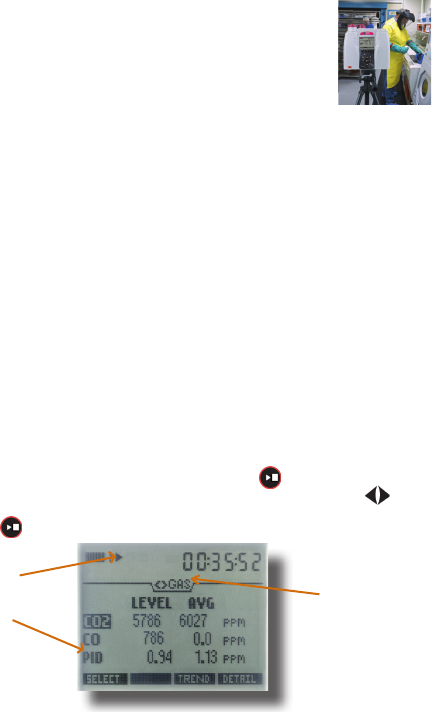
Volatile Organic Compounds (VOCs)
VOCs, air pollution with carbon-containing chemicals, are measured using a
Photoionization detector 10.6eV. The EVM is equipped to notify you when
maintenance and cleaning is required for the PID sensor. A PID sensor
error will appear indicating:
(1) if the sensor needs to be cleaned, or (2) the lamp needs replacing.
PID Zero Calibration
ThePIDppmzerocalibrationpreferredmethodistoushwithZeroGradeAir.Alternatively,
Nitrogenmaybeused.Forbestresponsetime,itisrecommendedtosettheowrateat1
LPM. NOTE: Please refer to the EVM series manual for more information on the PID ppm/
ppb sensors.
1.ConnecttheZeroGradeAir,tubing,andcal.cuptotheEVM.(Pleaseskip
this step if you are not applying a gas.)
2. Select Calibration from the Start screen and select PID (using up/down arrows).
3. Press Cal softkey and then press Zero softkey. Once level is stabilized, press Set
softkey. (Typically takes 60 seconds to stabilize.)
4. Once level has been set, you can press Save or Cancel. (Disconnect components
and return to the start screen via On/Off/Esc key.)
PID Span Calibration
Typically, Isobutylene is used when the VOCs are unknown. NOTE: in order to measure
specic VOCs, you will want to use the relevant VOC for your calibrated gas source for a
ppm/ppb sensors. (Please refer to the manual for PID correction factor table; Appendix C for details.)
1. Connect Isobutylene, regulator, tubing and cal cap to the EVM.
2.Followsteps2-4above(inPIDZeroCal.section)butselectSpan softkey instep 3.
Logging VOCs
1. From the start screen or any measurement screen, press key.
• ToviewVOCsmeasurements,selecteithertheGasorCompositescreenbypressing keys
from the start screen.
2. Press key to stop logging. (See “Viewing logged results” to access past sessions.)
PID sensor
measurement
Run icon
Gasmeasurement
screen














